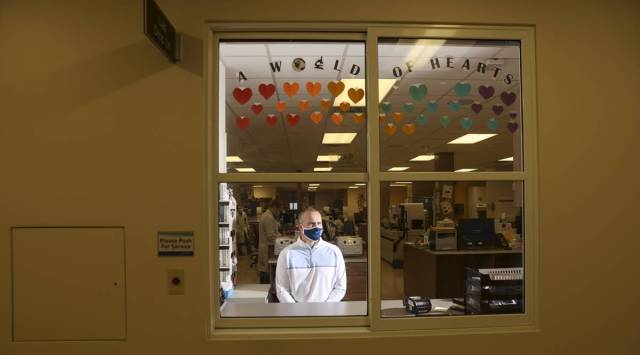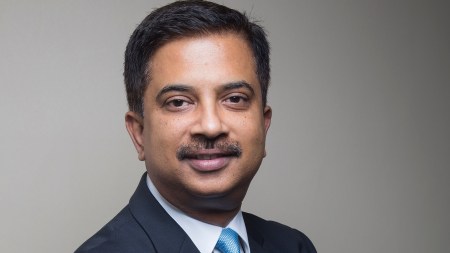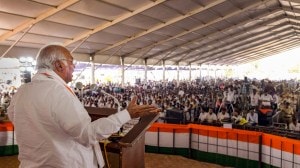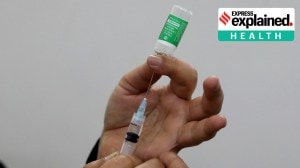- India
- International
Hospitals prepare for first shots as virus vaccine shipments blanket US
The United States is trying to turn the tide of battle against a virus whose out-of-control spread has killed nearly 300,000 people, ravaged the economy and upended millions of lives.
 Dr. Jesse Breidenbach, the senior executive director of pharmacy for Sanford Health, in the medical lab at the Sanford Medical Center in Fargo, North Dakota, on Sunday on Dec. 13, 2020. (The New York Times)
Dr. Jesse Breidenbach, the senior executive director of pharmacy for Sanford Health, in the medical lab at the Sanford Medical Center in Fargo, North Dakota, on Sunday on Dec. 13, 2020. (The New York Times)Trucks and cargo planes packed with the first of nearly 3 million doses of coronavirus vaccine fanned out across the country Sunday as hospitals rushed to set up injection sites and their anxious workers tracked each shipment hour by hour.
The distribution of the first federally approved vaccine marked the start of the most ambitious vaccination campaign in American history, a critical, complicated feat that one top federal official compared to the Allied landings at Normandy during World War II. Now, the United States is trying to turn the tide of battle against a virus whose out-of-control spread has killed nearly 300,000 people, ravaged the economy and upended millions of lives.
Early Sunday, the first boxes of a vaccine developed by Pfizer and BioNTech that received emergency approval from federal regulators were packed in dry ice at a Pfizer plant in Kalamazoo, Michigan. Workers applauded as the first truck left the plant, the earliest wave of vaccines bound for distribution sites across all 50 states.
The first doses will go to health care workers, who could start receiving shots by Monday. Residents of nursing homes, who have suffered a disproportionate share of COVID-19 deaths, are also being prioritized and are expected to begin getting vaccinations next week.
“I can’t wait to get it,” said Angela Mattingly, 57, a housekeeper at the University of Iowa Hospital who is scheduled to be among hospital employees receiving doses of the vaccine Monday morning. For months, she has done the draining work of cleaning up mountains of used personal protective equipment and even stripping curtains from the hospital rooms of COVID-19 patients.

“I just want all of our lives to get back to normal,” Mattingly said.
But the deaths and disruptions are likely to persist for months, since virus cases have soared in the United States and the vast majority of Americans will not be eligible for vaccinations until this spring or later. Health officials who have spent months urging Americans to wear masks and curtail normal life must now fight a new public health battle: convincing skeptical Americans that the vaccine is safe, and that its approval by federal regulators was not subject to political pressure from the Trump administration.
On Sunday, the U.S. Food and Drug Administration commissioner disagreed with President Donald Trump’s claims that the Pfizer-BioNTech vaccine could have been released a week ago. The commissioner, Dr. Stephen Hahn, said the FDA’s decision Friday to authorize the vaccine for emergency use was made as quickly as possible while still ensuring that it was safe and effective.
“We do not feel that this could have been out a week earlier,” Hahn said on the ABC News program “This Week.” “We went through our process. We promised the American people that we would do a thorough review of the application and that’s what we did.”
Across the country, governors and state health officials were preparing for the arrivals of vaccine shipments. Gov. Phil Murphy of New Jersey said the state would start vaccinations Tuesday with a first batch of 76,000 doses, but he urged people not to let their guard down.
“For all the good news, the light at the end of the tunnel — and the vaccine exemplifies that as much as anything — the next number of weeks are going to be hell, I fear,” he said on ABC’s “This Week.”
White House staff members who work in close quarters with Trump have been told that they are scheduled to receive injections of the coronavirus vaccine soon, according to two sources familiar with the distribution plans. Some White House officials said they were concerned about the perception that they were hopping the line.
John Ullyot, a National Security Council spokesperson, said that the vaccinations would follow protocols meant to ensure continued functioning of government and that “the American people should have confidence that they are receiving the same safe and effective vaccine as senior officials of the United States.”
Across the country, as FedEx and UPS trucks and planes began trundling the vaccines toward big-city hospitals, state health agencies and remote rural clinics, hospital officials and health care workers at the end of the dizzying distribution chain waited with a mixture of hope and nerves.
They watched for shipping updates. They prepared ultracold freezers needed to store Pfizer’s vaccine at temperatures of 94 degrees below zero Fahrenheit (minus 70 degrees Celsius).
They finalized details about which of their workers would receive this first, limited delivery of vaccines — which, in many cases, would not supply nearly enough doses to inoculate all of the doctors, nurses, security guards, receptionists and other workers who risk being exposed to the virus every day. Because the vaccines can cause side effects including fevers and aches, hospitals say they will stagger vaccination schedules among different departments.
Officials with Sanford Health, which operates hospitals and clinics across the Upper Midwest, spent the weekend huddling about their Day 1 vaccination plans, trying to game out where the shipments were most likely to arrive first.
On the snowy plains of Fargo, North Dakota, Jesse Breidenbach, the senior executive director of pharmacy for Sanford Health, refreshed his email again and again Sunday, waiting to receive a FedEx tracking number that would confirm that some 3,400 doses were en route.
The Sanford hospital in Fargo was converting its Veterans Club into a vaccination site, and officials said they were poised to start inoculating a first group of emergency and critical-care doctors and nurses within hours after the vaccine arrived. But when would that be?
“I try to be patient,” Breidenbach said. “Everybody’s ready. It’s just — what’s the timeline?”
The answer came Sunday afternoon: Expected vaccine delivery, 10:30 a.m. local time Monday, with vaccinations starting early in the afternoon.
The scene repeated itself at hospitals across the country.
“We’re just on pins and needles waiting to get our doses,” said Dr. Stephanie Jackson, the chief clinical value officer for HonorHealth, which operates six hospitals in the Phoenix metropolitan area.
Jackson said HonorHealth was planning to administer its first shots of the vaccine Thursday to as many as 5,000 members of its own staff, as well employees of neighboring health systems and nearby emergency medical workers. It expects the vaccine to arrive in Arizona on Tuesday.
HonorHealth has been preparing for the arrival for weeks, assembling ancillary kits, organizing items to use with the vaccines, and rehearsing in tents where the company will carry out the vaccinations.
Still, many in Arizona will have to wait. Jackson said she expected older patients to start receiving the vaccine sometime after the first of the year. “It doesn’t seem like the infrastructure is ready to do it any sooner,” she said.
While hospitals have long-established systems to deliver flu vaccines and ship medications from central hospitals to far-flung clinics, the arrival of such a new, high-profile vaccine forced new security measures up and down the distribution network. The vaccines were shipped on guarded trucks outfitted with sensors to monitor temperature, location and light exposure. Hospitals installed new security cameras, and several are being tight-lipped about where the vaccines will be stored and administered.
Dr. Jeff Salvon-Harmon, the chief patient safety officer for Presbyterian Healthcare Services, which operates several hospitals around New Mexico, said that while Presbyterian was going to distribute the vaccine at indoor locations in its facilities, he was refraining from providing more information about where.
“As you can imagine, with concerns over the novelty of the vaccine and risks of diversion or sabotage, we want to be sensitive to that and provide security,” said Salvon-Harmon.
Despite such concerns, Salvon-Harmon said the plan in the coming weeks was to administer the vaccine to Presbyterian’s entire workforce — about 15,000 people including independent medical staff — after prioritizing front-line caregivers who have direct contact with patients or infectious material.
In Miami, the Jackson Health System, a large hospital network that has treated more than 4,700 patients with COVID-19, has been buzzing with planning meetings, a virtual town hall, vaccine preparation training, and the reimagining of a pharmacy unit for wide-scale vaccinations.
Jackson is one of five early recipients in Florida and has assembled a team of pharmaceutical employees who will prepare doses to be administered to employees in large conference rooms.
Jackson is preparing to vaccinate up to 500 employees daily and distribute vaccines for other health care workers in the county.
But in rural areas where thinly staffed hospitals have been overrun by recent waves of coronavirus cases, some hospital officials said they had little idea when they would get vaccines or how many might arrive.
Andrew Bair, the chief executive of the 20-bed Ellsworth County Medical Center in central Kansas, has a new freezer ready to go, but said that an apparent technical glitch had forced his hospital to submit its vaccine application to state officials three times. He said he was not certain when the vaccine might arrive.
“I think we might be at the end of the line,” he said.
Public health experts say people who get vaccinated should keep wearing masks and taking other precautions given the uncertainties about whether vaccinated people can still transmit the virus to others.
Dr. Megan L. Ranney, an emergency room physician and public health researcher at Brown University in hard-hit Rhode Island, is scheduled to get her shot Thursday. As soon as the email arrived midday Friday notifying employees that they could schedule a time — “Here’s your link, go schedule your vaccine,” it said — a group-text thread with other doctors erupted in messages.
“I can’t wait till we can get together and have a glass of wine again,” read one.
Ranney said she could have received her shot as early as Tuesday, but knowing that she might feel under the weather for a few days after it, she chose a day when she would not be working in the hospital.
Apr 30: Latest News
- 01
- 02
- 03
- 04
- 05







































